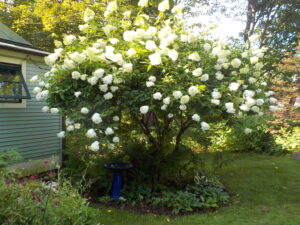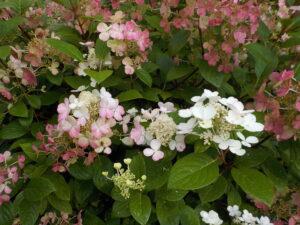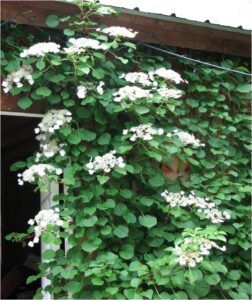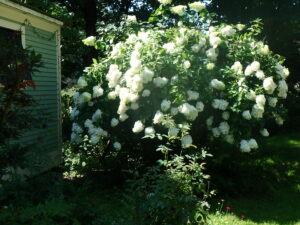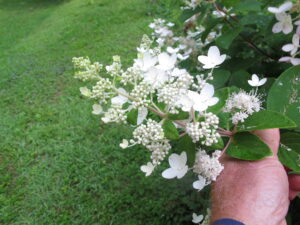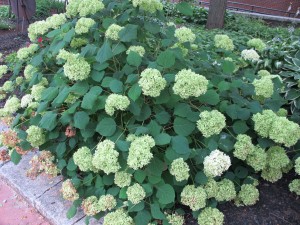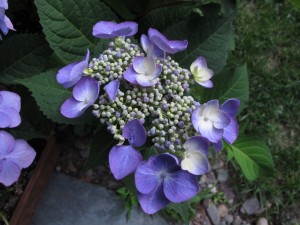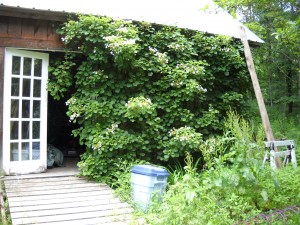Hydrangeas: You Always Win
The first standard I planted is what’s called a “PeeGee” hydrangea. PeeGee is shortened from the Latin name, Hydrangea paniculata grandiflora (which means large flower head). This is the classic cemetery plant, one that has been around since it was imported from Japan in 1862.
Another favorite of mine is called ‘Quick Fire’. Now in year five for me, it is a shrub about four feet tall and wide; it is loaded with 4- to 5- inch flower heads. It opens greenish white, then turn white, then pink. The pink color comes on earlier than most others, hence the name. What I like about it is that it keeps a nice mix of white and pink panicles. I am now pruning it yearly to keep it at its current size. It blooms on new wood, so I won’t lose any blossoms if I prune it now – or even in the early spring.
My favorite hydrangea is the climbing hydrangea, H. anomola subspecies petiolaris. Climbing hydrangea is usually sold as a small vine in a one-gallon pot. It takes a long time to get to blooming size – often five or six years. Then it takes off and grows rapidly.
Glorious Hydrangeas Are in Full Beauty Now
In the nursery trade the PeeGee hydrangea has fallen out of favor, mostly. Now ‘Limelight’, ‘Pinky Winky’ and others with jazzy names and bigger flowers are more popular. But I love my PeeGee that I planted some 25 years ago. It is blooming with over a hundred large white flowers now. It’s about 9 feet wide and 8-feet tall. Like most hydrangeas, if I wait until just before frost and cut some flower stems to put in a dry vase, they will look good all winter – and longer.
I like my ‘Pink Diamond’, a panicle hydrangea with strong stems and fewer florets per flower head than the PeeGee. That means it doesn’t get weighed down by rain, and droop to the ground like many other hydrangeas. It starts out white, then gradually turns pink. It is an excellent cut flower, too.
What about shade-growing hydrangeas? There are two nice ones. H. arborescens ‘Grandiflora’, also known as ‘Hills of Snow’ does well in shade. Its pompoms are much smaller than those of Annabelle, another of the same species, so it does not flop much after a rain. I like it better. It gets to be 5 or 6 feet tall and wide if left to its own, but many people cut it to the ground in late winter. The vigorous new growth will be shorter, and the pruning invigorates the plant.
My favorite shade hydrangea is the climbing hydrangea (H. anomala ssp. petiolaris). This tough vine will grow on the north side of a wall and can attach itself to brick or stone. It is slow-growing when young, but after 5 years or so becomes quite vigorous. I attached the stems of mine to the side of my barn when young, but later the stems slipped through cracks in the barn and hold on. Mine has even bloomed inside the barn!
Climbing hydrangea has showy white, sterile, petals on the outer rim of each flower panicle, and less showy, fertile flowers in the center. It blooms in June and the white petals stay white all year, so the flowers always look good. The vines have shaggy, exfoliating bark which is interesting in winter, too.
Chris had two hydrangeas I had not ever seen before that I like. The first, called “Great Star’ (H. paniculata ‘Great Star’) was first discovered in the gardens of Princess Greta Sturdza in Varengeville Sur Mer, Normandy, France. It appeared as a naturally occurring branch mutation of an unnamed seedling of Hydrangea paniculata. It has very prominent wide, strap-like sterile florets that are star-like. I hope to find a specimen and plant it in my garden.
Hydrangeas
Although I think of August as the month for hydrangeas, there are many kinds and some have been blooming for weeks while others are still in bud. Coming on now for me is the PeeGee (from the scientific name, Hydrangea paniculata grandifolia). I’ve had one for 20 years or so, and I love it.
Like all mid-and late-summer bloomers, PeeGee hydrangeas bloom on “new wood” – this year’s growth. Mine sends out perhaps a hundred 2 to 3-foot long stems, each with a big white panicle made up of hundreds of little flowers. Over time, the white changes to pink on many, and frost turns the panicles brown.
The flowers clusters on my PeeGee hydrangea are so big that their pencil-thick stems often cannot hold them up when they’re in full bloom. The flowers bend down the stems, particularly after a rain. Some years I snip off the tips of the panicles with pruning shears before they get to full size. This lessens the weight and the stems do not bend so much. The shrub is 8-10 feet tall and wide.
In one sense, the PeeGee hydrangeas are like daylilies: they will bloom every year, no matter what. They do best in full sun, but put will still on a good show in part shade. It prefers rich, moist, well drained soil – but will grow anywhere.
Another variety of hydrangea is the ‘Tardiva’ type. The flower panicles contain fewer florets and are a mix of fertile and infertile blossoms. The infertile ones have wider petals, and help to attract pollinators with their looks. The panicles are longer and more tapered than PeeGee hydrangeas, and rarely flop, even when wet. I have a cultivar named ‘Pink Diamond’ that I just love. It fades to a light pink. ‘Pinky Winky’ is another nice one that develops a deeper pink color.
The smooth hydrangea (H. arborescens) is another popular hydrangea, and one that will bloom well in shade. I particularly like ‘Snow Hill,’ which flowers well even in deep shade, and which produces nice small to medium-sized panicles that rarely flop. More popular, however, is ‘Annabelle’ because it produces huge flower panicles. But this variety always flops, especially after a rain, and I think they look as messy as an unmade bed. Annabelle is often used in perennial beds, even in full sun. In full sun it may require regular watering. The flowers start green, then go to white, and finally to brown, putting on a nice show for 6-8 weeks. The smooth hydrangea can be cut to the ground each fall or early winter and allowed to start anew each spring. I cut back ‘Snow Hill’ each fall, but do not cut it to the ground.
For those of us in cold climates, the blue or pink hydrangeas are best considered as annuals. Yes, many will survive a Zone 4 winter, but most times they will not produce many flowers after the first year. They are called bigleaf hydrangeas (H. macrophylla) for their handsome foliage, but we buy them for the color.
Bigleaf hydrangeas need very acidic soil (pH of 5.0 to 5.8) to have blue flowers, and a pH of 6.0 to 6.5 to be pink. On planting, you can add soil acidifier to get the blue color or limestone to get pink. Most blue ones come with some acidifier –usually sulfur- in the soil, but it goes away after a while.
Several years ago there was a huge fuss made over a variety of bigleaf hydrangea called ‘Endless Summer’ that was promised to thrive in Zone 4 (despite winters of minus 30 degrees). I often refer to it as ‘Endless Disappointment’ as I have tried it twice, and after Year #1 have only gotten a few blossoms very late in the summer.
This year I was given a nice blue one called ‘Twist and Shout’ At the website, it noted that it is a hybrid developed by Michael Dirr, one of America’s most noted horticulturists, and the author of the book I depend on to learn about trees and shrubs: Manual of Woody Landscape Plants: Their Identification, Ornamental Characteristics, Propagation and Uses.
I have my Twist and Shout in a large self watering container by the front door, but now that I know it was developed by Professor Dirr, I shall acidify a spot in full sun and plant it in the ground in the fall. The website says it is a re-bloomer, so does not just bloom on buds set the summer before, but on new wood, too.
Another great hydrangea that I grow is the climbing hydrangea (H. anomala subspecies petiolaris). It can take up to six years for a small plant to get established and start growing, but then it takes off and grows like mad. It is a vine that will thrive in shade, though it also can grow in sun, if provided adequate moisture. The north or east side of a building is perfect. It easily attaches to brick, stone or trees, but needs help to grow on a wood building. Mine sends flower shoots out horizontally and can support its handsome flowers without flopping 3 feet or more from the barn.
Henry Homeyer can be reached at P.O. Box 364, Cornish Flat, NH 03746 or at henry.homeyer@comcast.net. He is the author of 4 gardening books, and a children’s fantasy-adventure about a boy and a cougar called Wobar and the Quest for the Magic Calumet.



